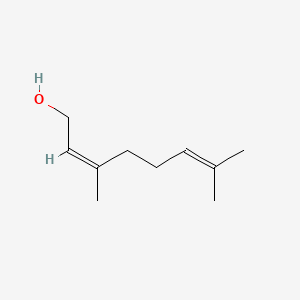| Authors | Title | Published | Journal | PubMed Link |
|---|---|---|---|---|
| Juarez A et al. | Disseminated allergic contact dermatitis after exposure to a topical medication containing geraniol. | 2008 May-Jun | Dermatitis | pmid:18627692 |
| Hagvall L et al. | Cytochrome P450-mediated activation of the fragrance compound geraniol forms potent contact allergens. | 2008 | Toxicol. Appl. Pharmacol. | pmid:18824010 |
| Takiguchi N et al. | Performance of mice in discrimination of liquor odors: behavioral evidence for olfactory attention. | 2008 | Chem. Senses | pmid:18178544 |
| Noge K et al. | Geraniol dehydrogenase, the key enzyme in biosynthesis of the alarm pheromone, from the astigmatid mite Carpoglyphus lactis (Acari: Carpoglyphidae). | 2008 | FEBS J. | pmid:18422649 |
| Jeon JH et al. | Mite-control activities of active constituents isolated from Pelargonium graveolens against house dust mites. | 2008 | J. Microbiol. Biotechnol. | pmid:18955817 |
| Sirak-Wizeman M et al. | Control of phlebotomine sandflies in confined spaces using diffusible repellents and insecticides. | 2008 | Med. Vet. Entomol. | pmid:19120969 |
| Togashi N et al. | Effects of two terpene alcohols on the antibacterial activity and the mode of action of farnesol against Staphylococcus aureus. | 2008 | Molecules | pmid:19078849 |
| Seo KA et al. | The monoterpenoids citral and geraniol are moderate inhibitors of CYP2B6 hydroxylase activity. | 2008 | Chem. Biol. Interact. | pmid:18611395 |
| Noe MC et al. | A short enantioselective synthesis of N-Boc-(2R,3R)-3-methyl-3-hydroxypipecolic acid from geraniol. | 2008 | J. Org. Chem. | pmid:18338902 |
| Mourtzinos I et al. | Encapsulation of nutraceutical monoterpenes in beta-cyclodextrin and modified starch. | 2008 | J. Food Sci. | pmid:18211376 |
| Müller GC et al. | Indoor protection against mosquito and sand fly bites: a comparison between citronella, linalool, and geraniol candles. | 2008 | J. Am. Mosq. Control Assoc. | pmid:18437831 |
| Müller GC et al. | Ability of essential oil candles to repel biting insects in high and low biting pressure environments. | 2008 | J. Am. Mosq. Control Assoc. | pmid:18437832 |
| Marcuzzi A et al. | Natural isoprenoids are able to reduce inflammation in a mouse model of mevalonate kinase deficiency. | 2008 | Pediatr. Res. | pmid:18391837 |
| Jain R et al. | Basil oil is a promising skin penetration enhancer for transdermal delivery of labetolol hydrochloride. | 2008 | Drug Dev Ind Pharm | pmid:18401780 |
| Ponzoni C et al. | Biotransformation of acyclic monoterpenoids by Debaryomyces sp., Kluyveromyces sp., and Pichia sp. strains of environmental origin. | 2008 | Chem. Biodivers. | pmid:18357555 |
| Lapczynski A et al. | Fragrance material review on nerol. | 2008 | Food Chem. Toxicol. | pmid:18640199 |
| Lapczynski A et al. | Fragrance material review on geraniol. | 2008 | Food Chem. Toxicol. | pmid:18640215 |
| Eyres GT et al. | Method for small-molecule discovery based on microscale-preparative multidimensional gas chromatography isolation with nuclear magnetic resonance spectroscopy. | 2008 | Anal. Chem. | pmid:18646864 |
| Yamamoto Y et al. | Synthesis of phosphatidylated-monoterpene alcohols catalyzed by phospholipase D and their antiproliferative effects on human cancer cells. | 2008 | Bioorg. Med. Chem. Lett. | pmid:18556205 |
| Maruyama N et al. | Protective activity of geranium oil and its component, geraniol, in combination with vaginal washing against vaginal candidiasis in mice. | 2008 | Biol. Pharm. Bull. | pmid:18670079 |
Nerol
Nerol is a lipid of Prenol Lipids (PR) class. The involved functions are known as Odorant, Anabolism, Diastasis, Metabolic Inhibition and Oxidation. Nerol often locates in germ tube. The related lipids are Octanols, Pinene, Hexanols, ethyl butyrate and ethyl hexanoate.
Cross Reference
Introduction
To understand associated biological information of Nerol, we collected biological information of abnormalities, associated pathways, cellular/molecular locations, biological functions, related genes/proteins, lipids and common seen animal/experimental models with organized paragraphs from literatures.
What diseases are associated with Nerol?
There are no associated biomedical information in the current reference collection.
No disease MeSH terms mapped to the current reference collection.
PubChem Associated disorders and diseases
What pathways are associated with Nerol
There are no associated biomedical information in the current reference collection.
PubChem Biomolecular Interactions and Pathways
Link to PubChem Biomolecular Interactions and PathwaysWhat cellular locations are associated with Nerol?
Visualization in cellular structure
Associated locations are in red color. Not associated locations are in black.
Related references are published most in these journals:
| Location | Cross reference | Weighted score | Related literatures |
|---|
What functions are associated with Nerol?
Related references are published most in these journals:
| Function | Cross reference | Weighted score | Related literatures |
|---|
What lipids are associated with Nerol?
Related references are published most in these journals:
| Lipid concept | Cross reference | Weighted score | Related literatures |
|---|
What genes are associated with Nerol?
There are no associated biomedical information in the current reference collection.
What common seen animal models are associated with Nerol?
There are no associated biomedical information in the current reference collection.
